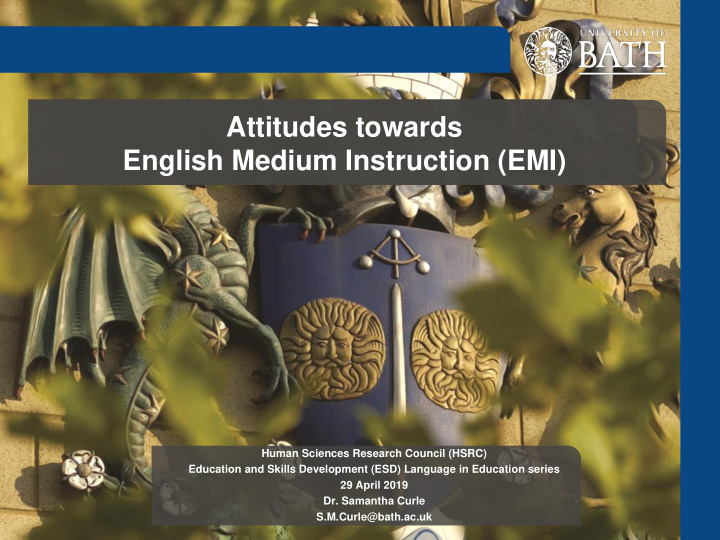



Attitudes towards English Medium Instruction (EMI) Human Sciences Research Council (HSRC) Education and Skills Development (ESD) Language in Education series 29 April 2019 Dr. Samantha Curle S.M.Curle@bath.ac.uk
Presentation Overview • Introduction to EMI: Definitions • What are the trends in attitudes towards EMI? • Measuring the complexity of attitudes (Japan) • Recent Research (Proficiency) • Current Research (Challenges)
Defining English Medium Instruction • EMI taken literally • A teaching and learning context where English is the medium of instruction • Macaro 2018, p. 18 • ‘ The use of the English language to teach academic subjects (other than English itself) in countries or jurisdictions where the first language of the majority of the population is not English’ • Humphreys 2017, p. 95 • Problematizes this: • Anglophone countries – teaching subjects through English • Large number of international students • English as an Additional Language (EAL) • Should another definition be developed for post-colonial multilingual countries such as South Africa? • Would this definition be more focused on English as a Lingua Franca? • English as a tool for peacekeeping?
Attitudes towards EMI (pg. 51-54) • Numerous studies beliefs/attitudes/perceptions (41 out of 83) • Trends very clear: • Negative: • Lack of Lecturer and/or Student proficiency (reported 60% comprehension) • + Could be a barrier to access EMI • Students simply prefer L1 • Lecturers concerned students can’t ‘thrive’ • Takes up more time • Feeling - no choice
Attitudes towards EMI • Positive: • Attract international students • Generate revenue • Globalisation – business – lingua franca • Increased job opportunities / career prospects • Study abroad • Intercultural understanding (less frequent) • Improve English ability • Access to teaching/learning materials • EMI is more interactive Study in Japan …
Background 2009 - Global 30 Project Financial support - 13 universities Attract and accommodate international students – declining Japanese 18yr olds 2014 – Top Global University Project (TGUP) Attract international students + promote international exchange (study abroad) + create active ‘global leaders’ (MEXT, 2014) Less focused on international students
Research Question • What are the main predictors of Japanese university professors/students’ attitudes towards EMI? a. Does Gender (Male/Female), Location (Tokyo/Kyoto), Academic Subject (STEM vs Social Science), and / or University Type (Private/National) statistically significantly predict attitudes towards EMI? b. Besides the four main predictor variables, are any other variables included in the statistical models statistically significant predictors of attitudes towards EMI?
Sample • Sample: 6 universities • 3 in Tokyo, 3 in Kyoto • 4 Private universities • 2 National universities • 57 professors • 485 students
Method • Questionnaire (development) • Interviews
Method (article: Appendix D) • JEMIAS – 13 dimensions
Main Findings • Professor data - Factorial MANCOVA • Student data - SEM • Gender ( GEN ) • Academic Subject ( ACAD_SUBJ ) • University Type ( UNI_TYPE ) • Location ( AREA ) • English proficiency
Why attitudes research? • Good starting point • Challenges • Motivations • Positive/Negative side-effects • Thoughts on impact of EMI • Not every context is the same • Nuances • Find out what is going wrong / right • Suggest changes in policy / practice
Recent Research
Recent Research
Current Research 1. What challenges do Japanese students face when studying through EMI? 2. Does English proficiency predict the level of challenge faced by EMI students in Japan? • Can a threshold of English proficiency that students need to reach be determined in order to mitigate EMI challenges? • If yes, what is this threshold for each skill? (Reading, Writing, Listening, Speaking)
Selected References • Rose, H., Curle, S., Aizawa, I., & Thompson, G. (2019). What drives success in English medium taught courses? The interplay between language proficiency, academic skills, and motivation. Studies in Higher Education , 0 (0), 1 – 13. https://doi.org/10.1080/03075079.2019.1590690 • Curle, S. (2018). Developing and Validating a Japanese English Medium of Instruction Attitude Scale (JEMIAS). The Journal of Asia TEFL , 15 (4), 900 – 1238. http://dx.doi.org/10.18823/asiatefl.2018.15.4.24.1195
Resource References • Please see comprehensive list in: • Macaro, E., Curle, S., Pun, J., An, J., & Dearden, J. (2018). A Systematic Review of English Medium Instruction in Higher Education. Language Teaching , 51 (1). • Download JEMIAS for free: • https://www.iris- database.org/iris/app/home/detail?id=york%3a936114&ref=sear ch • All papers downloadable from here: • https://www.researchgate.net/profile/Samantha_Curle
Recommend
More recommend